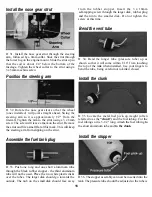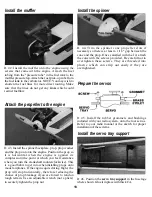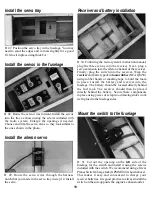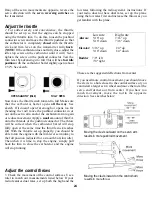
Use a "chicken stick" device or electric starter; follow
instructions supplied with the starter or stick. Make
certain that the glow plug clip or connector is secure
so that it will not pop off or otherwise get into the
running propeller.
Make all engine adjustments from behind the rotating
propeller.
The engine gets hot! Do not touch it during or after
operation. Make sure fuel lines are in good condition.
To stop the engine, cut off the fuel supply by pinching
the fuel line. Do not use hands, fingers or any body
part to try to stop the engine. Do not put anything into
the prop of a running engine.
AMA safety code (excerpt)
Read and abide by the Academy of Model Aeronautics
Safety Code, a portion of which is reprinted here:
GENERAL
1. I will not fly my model aircraft in sanctioned
events, air shows or model flying demonstrations until
it has been proven to be airworthy by having been
previously successfully flight tested.
2. I will not fly my model aircraft higher than
approximately 400 feet within 3 miles of an airport
without notifying the airport operator. I will give right-
of-way and avoid flying in the proximity of full-scale
aircraft. Where necessary, an observer shall be utilized
to supervise flying to avoid having models fly in the
proximity of full-scale aircraft.
3. Where established, I will abide by the safety rules
for the flying site I use and I will not willfully and
deliberately fly my models in a careless, reckless
and/or dangerous manner.
6. I will not fly my model unless it is identified with
my name and address or AMA number, on or in the
model.
8. I will not operate models with pyrotechnics (any
device that explodes, burns or propels a projectile of
any kind)...
RADIO CONTROL
1. I will have completed a successful radio
equipment ground range check before the first flight of
a new or repaired model.
2. I will not fly my model aircraft in the presence of
spectators until I become a qualified flyer, unless
assisted by an experienced helper.
3. I will perform my initial turn after takeoff away
from the pit or spectator areas and I will not thereafter
fly over pit or spectator areas unless beyond my
control.
4. I will operate my model using only radio control
frequencies currently allowed by the Federal
Communications Commission...
It is best if you let the instructor test fly the model first.
Once he has flown the model he will adjust the trim to
eliminate any turning, climbing or diving tendencies
that he found on the test flight. This will help make
your first flights much easier and safer. When first
learning to fly use the "low rates" for smoother control
(see page 24).
One thing to keep in mind with R/C models (whether it
be cars, boats or planes) is that the rudder and aileron
controls may seem to "reverse" when the model is
moving toward you. For example, if you are flying
toward yourself and you give a right control input
(ailerons or rudder), the model will move to your left.
The fact of the matter is, of course, that the controls are
not reversed and the aircraft did actually enter a right
turn. The plane does move to your left from your
vantage point, but if you imagined yourself in the
cockpit you would realize the plane turned to the right
as commanded. All it takes is a little practice to
maintain proper orientation of your aircraft, but that's
why we recommend finding an instructor.
There is a memory aid that may help keep you out of
trouble when the plane is flying toward you — "put the
stick under the low wing." In other words, move the
stick in the direction of the low wing to raise that wing.
When you are comfortable flying the aircraft, you can
practice using the rudder along with the ailerons to
'coordinate' the turns. Usually, a small amount of
rudder applied in the direction of the turn will keep the
tail following in the exact same track as the nose.
27


































